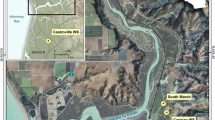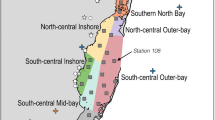Abstract
Oxygen depletion is a seasonally dominant feature of the lower water column on the highly-stratified, riverine-influenced continental shelf of Louisiana. The areal extent of hypoxia (bottom waters ≤2 mg l−1 dissolved oxygen) in mid-summer may encompass up to 9,500 km2, from the Mississippi River delta to the upper Texas coast, with the spatial configuration of the zone varying interannually. We placed two continuously recording oxygen meters (Endeco 1184) within 1 m of the seabed in 20-m water depth at two locations 77 km apart where we previously documented midsummer bottom water hypoxia. The oxygen meters recorded considerably different oxygen conditions for a 4-mo deployment from mid-June through mid-October. At the station off Terrebonne Bay (C6A), bottom waters were severely depleted in dissolved oxygen and often anoxic for most of the record from mid-June through mid-August, and there were no strong diurnal or diel patterns. At the station 77 km to the east and closer to the Mississippi River delta (WD32E), hypoxia occurred for only 50% of the record, and there was a strong diurnal pattern in the oxygen time-series data. There was no statistically significant coherence between the oxygen time-series at the two stations. Coherence of the oxygen records with wind records was weak. The dominant coherence identified was between the diurnal peaks in the WD32E oxygen record and the bottom pressure record from a gauge located at the mouth of Terrebonne Bay, suggesting that the dissolved oxygen signal at WD32E was due principally to advection by tidal currents. Although the oxygen time-series were considerably different, they were consistent with the physical and biological processes that affect hypoxia on the Louisiana shelf. Differences in the time-series were most intimately tied to the topographic cross-shelf gradients in the two locations, that is, station C6A off Terrebonne Bay was in the middle of a broad, gradually sloping shelf and station WD32E in the Mississippi River Delta Bight was in an area with a steeper cross-shelf depth gradient and likely situated near the edge of a hypoxic water mass that was tidally advected across the study site.
Similar content being viewed by others
Literature Cited
Chuang, W. S. andW. J. Wiseman, Jr. 1983. Low-frequency current variations west of Mississippi River Delta.EOS 64:1021.
Cochrane, J. D. andF. J. Kelly. 1986. Low-frequency circulation of the Texas-Louisiana shelf.Journal of Geophysical Research 91:10,635–10,659.
Cooley, J. W. andJ. W. Tukey. 1965. An algorithm for the machine calculation of complex Fourier series.Mathematics of Computation 19:297
Daddio, E., W. J. Wiseman, Jr., andS. P. Murray. 1978. Inertial currents over the inner shelf near 30°N.Journal of Physical Oceanography 8:728–733.
Dagg, M. J. 1988. Physical and biological responses to the passage of a winter storm in the coastal and inner shelf waters of the northern Gulf of Mexico.Continental Shelf Research 8: 167–178.
DiMego, G. J., L. F. Bosart, andG. W. Endersen. 1976. An examination of the frequency and mean conditions surrounding frontal incursions into the Gulf of Mexico and Caribbean Sea.Monthly Weather Review 104:709–718.
Dinnel, S. P. andW. J. Wiseman, Jr. 1986. Freshwater on the Louisiana shelf.Continental Shelf Research 6:765–784.
Dortch, Q., N. N. Rabalais, R. E. Turner, andG. T. Rowe. 1994. Respiration rates and hypoxia on the Louisiana shelf.Estuaries 17:862–872.
Endeco, Inc. 1988. Operations Manual for the Endeco Type 1184 SSM Pulsed Dissolved Oxygen and Temperature recorder. Endeco, Inc., Marion, Massachusetts.
Gordon, R. L. 1982. Coastal ocean current response to storm winds.Journal of Geophysical Research 87:1939–1951.
Justić, D., N. N. Rabalais, R. E. Turner, andW. J. Wiseman, Jr. 1993. Seasonal coupling between riverborne nutrients, net productivity, and hypoxia.Marine Pollution Bulletin 26:184–189.
Leming, T. D., andW. E. Stuntz. 1984. Zones of coastal hypoxia revealed by satellite scanning have implications for strategic fishing.Nature 310:136–138.
Lohrenz, S. E., M. J. Dagg, andT. E. Whitledge. 1990. Enhanced primary production at the plume/oceanic interface of the Mississippi River.Continental Shelf Research 10:639–664.
Milliman, J. D. andR. H. Meade. 1983. World-wide delivery of river sediment to the ocean.Journal of Geology 91:1–21.
Montgomery, R. B. 1938. Circulation in the upper layers of southern North Atlantic deduced with use of isentropic analysis. Papers in Physical Oceanography and Meteorology, 6, Massachusetts Institute of Technology and Woods Hole Oceanographic Institution, Woods Hole, Massachusetts.
Murray, S. P. 1976. Currents and circulation in the coastal waters of Louisiana. Louisiana State University, Center for Wetland Resources, Coastal Studies Institute, Technical Report No. 210. Baton Rouge, Louisiana.
Parsons, T. R., Y. Maita, andC. M. Lalli. 1984. A Manual of Chemical and Biological Methods for Seawater Analysis. Pergamon Press, New York.
Pavela, J. S., J. L. Ross, andM. E. Chittenden, Jr. 1983. Sharp reductions in abundance of fishes and benthic macroinvertebrates in the Gulf of Mexico off Texas associated with hypoxia.Northeast Gulf Science 6:167–173.
Pokryfki, L. andR. E. Randall. 1987. Nearshore hypoxia in the bottom water of the northwestern Gulf of Mexico from 1981 to 1984.Marine Environmental Research 22:75–90.
Rabalais, N. N., L. E. Smith, E. B. Overton, andA. L. Zoeller. 1993. Influence of hypoxia on the interpretation of effects of petroleum production activities. OCS Study/MMS 93-0022. United States Department of the Interior, Minerals Management Service, Gulf of Mexico OCS Region, New Orleans, Louisiana.
Rabalais, N. N., R. E. Turner, W. J. Wiseman, Jr., andD. F. Boesch. 1991. A brief summary of hypoxia on the northern Gulf of Mexico continental shelf: 1958–1988, p. 35–47.In R. V. Tyson and T. H. Pearson (eds.), Modern and Ancient Continental Shelf Anoxia. Geological Society Special Publication No. 58, The Geological Society, London.
Rabalais, N. N., R. E. Turner, andW. J. Wiseman, Jr. 1992. Distribution and characteristics of hypoxia on the Louisiana shelf in 1990 and 1991, p. 15–20.In Nutrient Enhanced Coastal Ocean Productivity. Publication Number TAMU-SG-92-109, Sea Grant Program, Texas A&M University, Galveston, Texas.
Renaud, M. 1986. Hypoxia in Louisiana coastal waters during 1983: Implications for fisheries.Fishery Bulletin 84:19–26.
Science Applications International Corporation. 1989. Gulf of Mexico Physical Oceanography Program, Final Report: Year 5. Vol. II, Technical Report. OCS Report/MMS-89-0068. United States Department of the Interior, Minerals Management Service, Gulf of Mexico OCS Region, New Orleans, Louisiana.
Sklar, F. H. andR. E. Turner. 1981. Characteristics of phytoplankton production off Batataria Bay in an area influenced by the Mississippi River.Contributions in Marine Science 24:93–106.
Turner, R. E. andR. L. Allen. 1982. Planktonic respiration rates in the bottom waters of the Mississippi River Delta Bight.Contributions in Marine Science 25:109–120.
Wiseman, W. J., Jr.,V. J. Bierman, Jr.,N. N. Rabalais, andR. E. Turner. 1992. Physical structure of the Louisiana shelf hypoxic region, p. 21–26.In Nutrient Enhanced Coastal Ocean Productivity. Publication Number TAMU-SG-92-109, Sea Grant Program, Texas A&M University, Galveston, Texas.
Wiseman, W. J., Jr.,S. P. Murray, J. M. Bane, andM. W. Tubman. 1982. Temperature and salinity variability within the Louisiana Bight.Contributions in Marine Science 25:109–120.
Wiseman, W. J., Jr.,R. E. Turner, F. J. Kelly, L. J. Rouse, Jr., andR. F. Shaw. 1986. Analysis of biological and chemical associations near a turbid coastal front during winter 1982.Contributions in Marine Science 29:141–151.
Author information
Authors and Affiliations
Rights and permissions
About this article
Cite this article
Rabalais, N.N., Wiseman, W.J. & Turner, R.E. Comparison of continuous records of near-bottom dissolved oxygen from the hypoxia zone along the Louisiana coast. Estuaries 17, 850–861 (1994). https://doi.org/10.2307/1352753
Received:
Accepted:
Issue Date:
DOI: https://doi.org/10.2307/1352753




